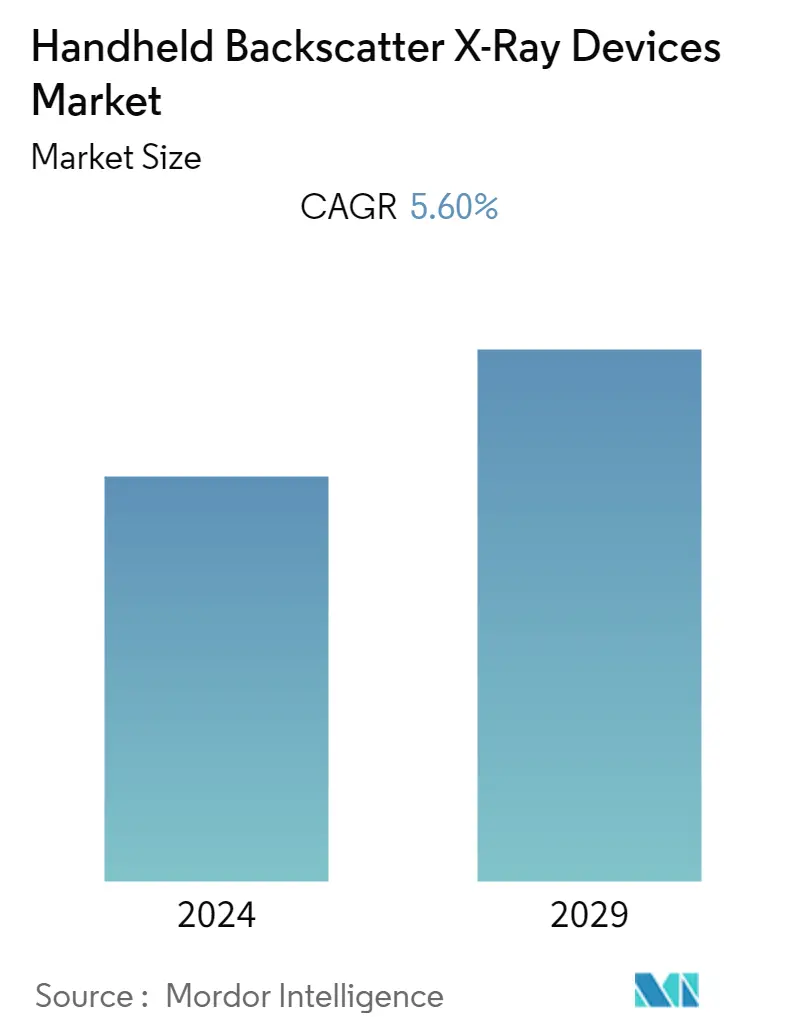Market Size of Handheld Backscatter X-Ray Devices Industry

| Study Period | 2019 - 2029 |
| Base Year For Estimation | 2023 |
| CAGR | 5.60 % |
| Fastest Growing Market | Asia Pacific |
| Largest Market | North America |
| Market Concentration | High |
Major Players
*Disclaimer: Major Players sorted in no particular order |
Need a report that reflects how COVID-19 has impacted this market and its growth?
Handheld Backscatter X-Ray Devices Market Analysis
The Global Handheld Backscatter X-ray Devices Market was valued at USD 47.83 million in 2020, and it is expected to reach USD 67.73 million by 2026, registering a CAGR of 5.6% during the forecast period, 2021-2026.
A significant consideration to opt for a handheld version of backscatter X-ray has been observed amid the COVID-19 situations. As the police work can force officers to break that 6-foot social distance guideline, investment toward these devices helps law enforcements keep their distance. As of June 2020, Viken Detection, by building on its VALOR program, led the US-based police departments across Oklahoma, Tennessee, Mississippi, Georgia, and Indiana to training sessions in its Burlington facility on using the HBI-120 to ensure the active protection of the public from the opioid crisis amid coronavirus-led challenges.
- X-ray backscatter technology (XBT) uses scattered radiation caused by the Compton effect. The backscatter imaging involves illuminating the object with a pencil beam of known direction and collecting all the back-scattered radiation with large area detectors. The advantage of XBT lies in the inspection of an object from one side. Therefore, it is beneficial to deploy where limited access points exist or when the interior of the object is complex in terms of overlaying details.
- The trend of miniaturization of devices and ease to use have led to the development of handheld variants. These variants, though, are required to possess capabilities on-par or sometimes even sophisticated than the fixed ones. The ability to shrink the X-ray tube has been one of the primary drivers to achieve the development of handheld devices in this domain. Such advancements in the miniaturization of X-ray inspection technology have helped the upstream oil and gas sector in recent times.
- The increasing need for highly efficient and easy-to-use scanning systems is driving the market. Vehicles to screen for the detection of drugs, IEDs, to name a few, are being increasingly used across the world to smuggle in a country or region. Therefore, increased need for providing X-ray images from backscatter to detect organic-based threat materials as well, in addition to metal (lead detection), in passenger vehicles, public events, and borders are gaining traction. Also, these handheld devices/equipment offer a better return on investment (ROI).
- Countries like Islamic Republic of Iran and Morocco, reported multiple large drug seizures, indicating that large-scale drug trafficking is taking place amid the COVID-19 led restrictions, also reported an increase in interdiction resulting from increased controls. The convenience offered by handheld backscatter X-Ray devices would help reduce trafficking.
- The handheld backscatter X-ray device costs significantly higher due to exceptional and proprietary advantages and the presence of a consolidated market as well. Also, while using the device for scanning more expansive areas, the power input gets easily hampered. This is because of the availability of 5W and 10W power source. The device gets heated up. Therefore, higher energy input in similar or reduced dimensions is needed. Furthermore, the ergonomic design of the product is still not standardized. The current dimensions and weight of the product are still not appropriate for personnel to hold it for a longer duration.
